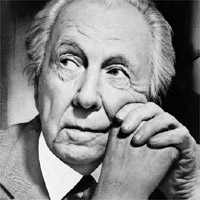Frank Lloyd Wright Biography
Frank Lloyd Wright is widely regarded as one of the most influential
figures in modern Western architecture. His radically innovative designs,
utilizing a building style based on natural forms, termed by Wright
as organic architecture, have stamped him as a major, respected architect.
Frank Lloyd Wright was born in Richland Center, Wisconsin, June 8, 1867
and died on April 9, 1959. It is a measure of his passion and commitment
to his field that he continued working right up to the time of his death.
After studying civil engineering at the University of Wisconsin, Wright
moved to Chicago in 1887, where he went to work as a draftsman in the
office of Adler and Sullivan. While working under Louis Sullivan, he
began to design and independently build private houses
 |
for some of Adler and Sullivan’s clients. These "bootlegged
houses", as Wright called them, soon revealed an independent talent
quite distinct from that of Sullivan. Wright’s houses had low,
sweeping rooflines hanging over uninterrupted walls of windows; his
plans were centered on massive brick or stone fireplaces at the heart
of the house; his rooms became increasingly open to one another; and
the overall configuration of his plans became more and more asymmetrical,
reaching out toward some real or imagined expansive horizon. The architecture
of these houses served as the inspirational source for the Prairie School.
In contrast to the openness of those houses and as if in conflict with
their immediate city environment, Wright’s urban buildings tend
to be walled in with light entering primarily from above, through skylights,
Interestingly, these features contrasted with those of Sullivan’s
buildings. Wright’s distaste for urban environments and his embrace
of the natural environment are observed in the contrasting features
of some of his finest buildings of the early 1900s: the Larkin Company
Administration Building (1904; demolished 1950) in Buffalo, New York,
and the Unity Church in Oak Park, Illinois; compared with Buffalo’s
Martin House and Chicago’s Robie House. The houses are characterized
by large, glazed walls, terraces, and low-slung roof overhangs.
After 1893, when the issue of his bootlegged houses finally caused a
break with Adler and Sullivan’s office, Wright struck out on his
own. During the next 20 years, he became one of the best-known architects
in the United States. Wright’s fame in European architectural
circles was promoted due to the publication in 1910 and 1911 by Berlin’s
Wasmuth of two editions of Wright’s work as well as an exhibition
that traveled throughout Europe. Wright’s influence now spread
to include such key figures in contemporary architecture as Mies van
der Rohe and Le Corbusier.
 |
With his reputation assured on both sides of the Atlantic, Wright began
to reinforce the philosophical underpinnings of his innovative building
style. In keeping with his rural leanings, Wright proclaimed that the
structural principles found in natural forms should guide modern American
architecture. He praised the virtues of an organic architecture that
would use reinforced concrete in the configurations found in sea shells
and snails and would build skyscrapers the way trees were "built";
that is, with a central "trunk" deeply rooted in the ground
and floors cantilevered from that trunk, like branches. Spaces within
such buildings would be animated by natural light allowed to penetrate
the interiors and to travel across textured surfaces as the angle of
sunlight and moonlight changed.
Wright’s view of architecture was essentially romantic. Although
he often paid lip-service to the rational systems called for by mass
production (modular planning and prefabrication), his efforts in those
directions seemed half-hearted at best. The most spectacular buildings
of his mature period were based on forms borrowed from nature, and the
intentions were clearly romantic, poetic, and intensely personal. Examples
of these buildings are: Tokyo’s Imperial Hotel (1915-22; demolished
1968); Fallingwater (Kaufmann House; 1936), Mill Run, Pa.; the SC Johnson
and Son Wax Company Administration Center (1936-50), Racine, Wis.; Taliesin
West (1938-59); and New York City’s Guggenheim Museum (completed
1959).
Frank Lloyd Wright has left a rich heritage of completed buildings of
almost uniform splendor, but, unlike Walter Gropius, Mies van der Rohe,
Le Corbusier and others, he has nurtured few disciples. Wright can be
considered an essentially idiosyncratic architect whose influence was
immense but whose pupils were few.
Source: Frank
Lloyd Wright Bio |

